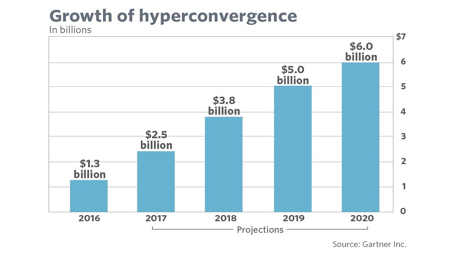As virtualisation becomes more prevalent in the datacentre the legacy hardware systems used to deliver the underlying compute, storage and networking have moved on. Hyperconvergence has been heralded as a major breakthrough in data centre planning and design. Previously, those core elements of a data centre were all separate components requiring separate dedicated management. Hyperconverged Infrastructure (HCI) with a software centric architecture, integrates compute, storage, networking and virtualisation resources into one single box system provided by a single vendor. Developed as an evolution of converged systems, where a vendor provided a pre-configured bundle of hardware and software, hyperconvergence delivers even greater simplicity and flexibility when compared with legacy systems. With converged infrastructure, the compute, storage and networking components can be separated, whilst with HCI these components are self-contained, constructed around a single software platform composed of various nodes. When more resources are needed, it is easy to acquire more nodes that can be added to the technology stack, and adding drives, memory or CPUs, allows hyperconverged systems the flexibility to scale much more cost effectively than traditional architecture.
Hyperconvergence also makes it easier to store and manage data spread across private servers and the public cloud from a single appliance, critical for companies that use a “hybrid” approach to the cloud. Companies don’t have to choose between buying their computing power on-premise or through public cloud offerings. While cloud computing has become popular, many experts consider a hybrid approach will prevail in the end, as companies look to keep their most important or sensitive data on servers they own and maintain. Naturally, there is always concern about the possibility of security breaches on the public cloud. Companies of all sizes want the commercial and technical agility that the public cloud offers whilst ensuring any data that is core to their business remains on-premise, with anything on the periphery being pushed out to the public cloud. Impending GDPR regulations together with the possibility of heavy fines for any breach, may well influence companies to keep this data on-premise, particularly as they will remain liable even if the breach occurs at a third party.
What are the business benefits?
With IT budgets always at a premium, businesses need to continually look at efficiency gains and cost control. An IDC case study revealed that converged infrastructure is driving savings and efficiencies for companies of all sizes. Indeed, the report claimed a 70 per cent improvement in the speed of infrastructure deployment together with a 78 per cent saving on network hardware costs and 43 per cent reduction in storage costs.
Hyperconverged infrastructure delivers simplicity and flexibility when compared with legacy systems that often require multiple management systems and are costly to scale. More resources often demand more hardware which adds to the complexity of the infrastructure. Hyperconvergence lets companies scale up or down according to requirements, simply by adding new nodes. In addition, for IT departments, HCI allows its staff the opportunity of managing the infrastructure through a centralised platform by consolidating a number of separate functions and services into one piece of technology that can adjust workloads and resources from one place. Because there aren’t any multi-vendor integrations to consider, HCI can be rapidly deployed and refreshes easier to manage. Some IT departments have been able to downsize or their staff be deployed in more business-oriented projects as a result.
HCI can also make it easier to implement patches and updates, provide better protection of company data and provide for extensive back-up and data recovery which is increasingly important with the impending GDPR legislation.
What’s the opportunity?
Gartner projects that hyperconvergence revenue will grow at a compounded annual rate of more than 60% in the next few years.

According to the analyst, the worldwide market for hyperconverged systems could reach $2.5 billion by the end of this year, and continue growing to $5.0 billion by 2019. The analyst expects such systems to represent 15 per cent of total storage spend by 2018 and projected to be the fastest growing segment of storage with a share of 32 per cent by 2020. Research consultants TBR reported that enterprises were increasingly moving away from cumbersome legacy SAN systems and deploying hyperconvergence focused on operations like analytics, back-up and recovery, and business centric workloads such as ERP. Equally, HCI has opportunities for small to medium sized business looking for cost-effective enterprise-level solutions. Those customers will have less resource to manage HCI internally and offer both deployment and managed service opportunities for resellers.
According to IDC’s worldwide Quarterly Converged Systems Tracker, Dell EMC has recently become the leader in infrastructure (HCI) sales. The analyst maintained that Dell EMC’s share of the HCI segment grew to 29 per cent in the second quarter of 2017, representing year-over-year growth of 149 per cent.
In what is a growing market, resellers should work with their distribution and vendor partners on how to deliver HCI solutions, and start talking to their customers about the benefits.
Sources & Acknowledgements: IDC, Gartner, TBR, TechTarget, TechAdvisory .org, MarketWatch

